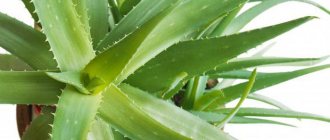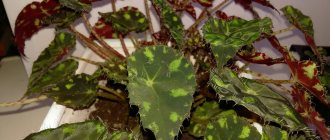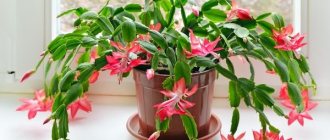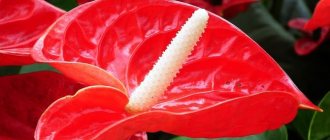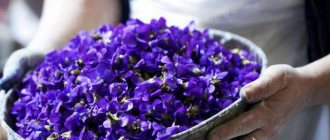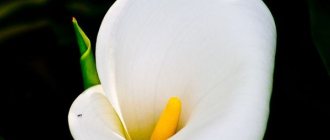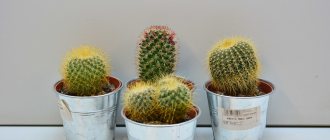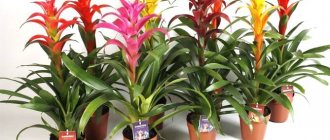Home — Botany — Houseplants — Turning the house into a tropical garden — basic recommendations for caring for Guzmania
The Guzmania indoor flower is an epiphyte from South and Central America. In nature, it grows on dying trees and receives moisture from the air. In indoor culture, this is an ordinary potted plant, quite unpretentious, but requiring compliance with several simple conditions.
The bright bracts are mistaken for flowers. Real Guzmania flowers are inconspicuous and short-lived.
The plant is evergreen tuft of long leaves with a bright, beautiful pre-flower and a short-lived flower. Guzmania is valued precisely for the leaves surrounding the flower - they can be pink, brownish and yellow, bright red and burgundy. In a room it rarely grows more than 40 cm, since it is problematic to provide “tropical” conditions in our homes.
Reed, aka Minor.
Houseplant Calathea - description
From Latin the name “calathea” is translated as “basket”. This name is not because the indoor flower itself looks like a basket, but because of the leaf veins. They are dense and thick, so in ancient Greece they were actually used for weaving baskets.
Calathea belongs to the arrowroot family, and therefore, like all representatives of this family, it loves moisture very much. Perennial. Nowadays it is no longer used for weaving baskets, but is used for decorating rooms: it has large, beautiful leaves, and breeders have developed various varieties - with red leaves, pink leaves, pink veins and many other various decorations.
Calathea is beautiful, but rather capricious in terms of moisture levels. But it also has a positive feature: unlike many ornamental plants, it prefers shade rather than sun.
It is also known as the flower that raises its leaves at night. This is true: at night its leaves curl, and in the morning they bloom again. Because of this, she got the nickname “prayer flower”: as if he prays in the evenings and mornings.
What does calathea look like?
The plant is quite large, sometimes even resembling not a flower, but a tree: it reaches eighty centimeters in height, and the leaves are large, round, up to thirty centimeters in length. They grow in several stems-shoots from one rhizome.
The colors of the leaves can be very different, since there are many varieties of decorative calathea. Breeders also try to develop varieties with different patterns on the leaf blades, so two plants belonging to the same calathea species can look completely different.
Where it grows - the birthplace of the plant
Central and South America, shady, humid tropics.
How indoor calathea blooms
As with many plants whose main decorative value is their leaves, potential owners have the question “does calathea bloom or not at all?” Of course it blooms.
Flowering time: late spring, summer. The flowers are small, collected in small delicate spikelets, and come in pink, white, purple, orange and other colors.
Is Calathea poisonous or not?
It has poisonous juice. However, in Asian countries, the leaves of this plant are even used as plates, they wrap food in them, so calathea is absolutely safe - you are not going to chew the leaves to get juice from them. But you should not allow animals or children near the plant - they are not so prudent.
How to prolong the pleasure - propagating Guzmania
Growing this tropical beauty is easy. But there comes a time when the flower dies and the plant loses its decorative effect. You can preserve the “tropical paradise” if you know how Guzmania reproduces .
Even during the flowering period, the plant forms a “baby” - usually one. The young flower grows very quickly and by the time the “parent” dies, it will already reach 15 centimeters in height. It is easy to know that a plant is ready to divide: the bract begins to dry out and the leaves turn pale.
Important! Before dividing, check that the children have roots. If they grow poorly, remove the peduncle in advance - this will stimulate their development.
After the mother plant withers, the children can be separated - this is done with a sharp knife. Baby Guzmania should be immediately planted in the prepared substrate, and the pot should be small, because the plant is small. Remember to use drainage to prevent your young plant from dying from overwatering. Reproduction of Guzmania is not difficult, so very soon you will be delighted with new bright flowers.
Anthurium - how to grow, how to care for, how to propagate. This indoor flower is called male happiness, and it is believed that it brings love and harmony between spouses to the house.
It turns out that aloe can be grown not only for health, but also for beauty. More details can be found here.
What to do with the huge aerial roots of indoor monstera? The answer to this question can be found at the link www.razmnojenie.ru/botanika/komnatnye-rasteniya/monstera.html.
How to care for Calathea at home
Caring for calathea is not too difficult; the most labor-intensive thing here is to provide the required level of humidity. Here are the factors you need to consider.
Replanting after purchase
Optional, but desirable, since it is unknown what is contained in store-bought soil (and it is usually scanty), and if you replant the flower, you will know for sure. Transplantation after purchase is no different from the usual one, described in the corresponding section below.
Please note that if a new pet blooms, it is better not to replant - flowering will immediately stop due to stress, so wait until it is finished. It is also better not to replant in winter, but to wait until at least early spring.
Lighting
Soft, diffused, partial shade desirable. Completely artificial lighting is not suitable; the calathea should receive sunlight, but only indirect light - it easily gets sunburned. If you put it on the balcony, be sure to block it from the sun with at least a curtain.
Temperature
The range of acceptable temperatures is quite wide: 16-24⁰С. Drafts and sudden changes in temperature (for example, suddenly opening a window in cold weather) are unacceptable; they lead to leaf rot.
Humidity
Very high is required, up to 90%. How to ensure this humidity:
- If you have a variety with glossy, smooth leaves, then wipe the flower every day with wet wipes, put it in the shower, and spray it (only warm water).
- If the variety has velvety, fleecy leaves, place the pot in a tray with wet pebbles (the pebbles should lie around, the bottom of the pot does not come into contact with them) and make sure that they are always wet. Be sure to wipe the leaves with a dry cloth to remove dust.
- Place in an aquarium or florarium.
- Keep away from heating devices. Calathea tolerates lack of light more easily than too dry air.
How to water a calathea
It is quite capricious regarding water quality and does not tolerate traces of lime. The water should be soft, ideally melt or rain. If it is not possible to water one, then the night before watering, you need to place peat wrapped in cloth in the water so that it disinfects and softens the water, and water it the next morning.
Do not let water drop on the leaves when watering, because if the wet leaves are then exposed to the sun, they will cause sunburn. Also, do not forget to drain the water from the pan to prevent rotting of the roots.
In summer
Two to three times a week.
in winter
Watering is reduced to once a week due to the fact that moisture evaporates more slowly.
Fertilizer and feeding
Feed from April to August, twice a month. Saffron calathea is fertilized with fertilizer for ornamental flower plants, and all other types - for plants with decorative foliage. There should be no nitrogen and calcium in the fertilizing. The dose of fertilizing is reduced by half from that indicated on the package.
General description of the plant
Reo flower is a tropical perennial native to Mexico. Currently it belongs to the genus Tradescantia, although previously it was classified as an independent genus Reo (lat. Rhoeo). The flower received its mysterious name in honor of the ancient Greek deity of nature, the nymph Reo, so it is more correct to name the plant in the feminine gender, for example, Reo tepalsata.
Its other names are no less interesting - the Boat of Moses or the Cradle of Moses. Probably the plant acquired these names thanks to small white flowers, comfortably located among the bract leaves, reminiscent to some of a boat, and to others of a cradle rocking in the waters of the Nile with the biblical baby Moses. In the photo you can admire the flowering plant.
First of all, flower growers value Reo for its decorative foliage, which is not only monochromatic (green or purple), but also has stripes of different colors: white, pink or yellow. At the same time, its small delicate flowers in boat bracts are quite elegant and attractive.
The Reo flower was once brought to Europe and Russia from the tropics of Africa. It is valued by lovers of indoor plants, primarily for its decorative foliage. Reo's flowers are also quite beautiful. The long, narrow leaves of this plant are green on top and purple underneath. Sometimes striped varieties of Reo are also found on sale in specialized stores.
Description of Reo:
- has long sword-shaped leaves, painted greenish-olive on the outside and purple on the inside;
- some varieties have yellowish stripes;
- as it grows, the leaves fall off and the plant acquires an external resemblance to a palm tree;
- reaches a height of 30-40 cm;
- blooms briefly with small white flowers, regardless of the time of year;
- The stem is strong and erect.
Reproduction of calathea at home
Calathea can be propagated by cuttings (including leaves), dividing the bush or planting seeds. For the first three methods, you will need to perform a small surgical operation - to separate part of the plant. Therefore you will need:
- A sharp tool – scissors or a knife. They must be well sharpened, because you will need to separate part of the plant in one movement, without breaking or sawing, because such movements contribute to wounds that take longer to heal, accordingly, your pet is more vulnerable during this period.
- Alcohol or a saturated solution of potassium permanganate to disinfect instruments before surgery.
- Also, to disinfect the sections, you will need crushed activated carbon - you will sprinkle it on the sections.
- The cuts are made obliquely (at an angle of 45 degrees) - these are easier for the plant to heal and grow a new shoot in its place.
- Gloves to avoid getting your hands dirty with soil.
- Containers for small plants or one large container for seeds. For starters, just plastic cups filled with a special mixture for young plants (which will be discussed below) are suitable.
- Polyethylene or glass, because calathea is, in principle, a moisture-loving plant, and especially its seedlings.
It is best to propagate in the spring, so that the seedlings have favorable summer conditions for formation, and the mother plant calmly survives the stress of such manipulations. So, let's take a closer look at each method of propagating calathea at home.
Leaf
What needs to be done: cut a leaf from the calathea (healthy, large, whole, without damage, elastic) and plant it in a separate small pot with moist soil, cover with a greenhouse.
The greenhouse is removed when the leaf gives its first roots. Before this, you need to check whether condensation remains on the glass or film - it needs to be removed with a cloth and the sheet ventilated. Please note that this is the most unreliable method, unlike, for example, succulents, calatheas are difficult to propagate by leaf.
Cuttings
The same as with a leaf, but instead of one leaf, a whole cutting is taken - a stem with several leaves from twelve centimeters.
Dividing the root
This method is much more reliable, since calathea itself is prone to forming several rhizomes, which can be easily divided into individual plants. Most often, propagation by division is carried out during transplantation.
What needs to be done: use a knife or scissors to separate part of the rhizome so that it is like its own separate plant with everything necessary for life - root, stem, leaves.
I plant this plant in a separate pot (nine centimeters in diameter, no more), filled with a mixture of sand and peat. These pots should be placed in a place where there is no sun, but it will be warm (about 20⁰C), watered abundantly and covered with polyethylene or glass. The next watering is carried out when the substrate dries.
When the first independent leaves appear on the cutting, it can be transplanted into a larger pot and cared for like an adult plant. Please note that this will not happen immediately; calathea takes a long time to take root.
Seeds
The method is unreliable, since often even freshly collected calathea seeds do not germinate. Therefore, try to plant more so that at least a few sprout.
What you need to do: fill the container with two parts of leaf soil and one part of sand and sow the seeds in them.
The container is placed in a warm place where the temperature is always around 25⁰C. The soil should always remain slightly moist and not dry out. The greenhouse above the container must be cleared of condensation and ventilated for 10 minutes a day.
When the seedling has the first pair of leaves, it can be transplanted into a separate small pot. Please note that most often plants grown in this way do not retain the characteristics of their variety.
Calathea transplant at home
Planting calathea in a new pot is easy.
When to replant
The best time of year for replanting is early spring, when the calathea has recently emerged from hibernation, since a flowering or dormant pet may not be able to cope with the stress of moving to a new place.
Young (up to 3 years old) calathea must be replanted annually, and then once every two to three years. The main reason why a transplant may be required is that the pot has become “small”. This can be seen from the fact that the roots began to protrude from the ground - which means they have nowhere to grow.
Flowers are also replanted for sanitary purposes: for example, if you have over-watered and the plant has rotted (then it is often easier to replant than to wait for the soil to dry out), or if a fungus or pest has infested.
If transplantation is a measure of medical care, then it is carried out at any time of the year: it is more important to save the calathea than not to expose it to stress.
Priming
A slightly acidic soil that does not contain lime is suitable. This is, for example, the soil for azaleas and rhododendrons. You can also make the soil yourself.
So, what kind of soil is needed for planting calathea, what is the composition:
- You will need calcined river sand (it must first be placed in an oven heated to one hundred degrees for half an hour, and then left in a well-ventilated place for ten days so that beneficial microorganisms can grow there) - it will make up half of the soil mixture.
- The second half will be taken up by: leaf soil, humus, peat. As “vitamin supplements” you can put a little crushed coal (prevention against pests) or pieces of pine bark.
Pot
Small, since the root system of calathea usually does not grow too much. Each new pot is one third larger than the previous one (if the transplant is carried out for the reason “the previous pot has become small”). The material doesn't matter.
Action plan
- Prepare the pot and soil for replanting in advance. Also prepare a knife or scissors, because when replanting it is convenient to inspect the root system for rot and remove rotten parts.
To disinfect the sections you will need crushed activated carbon. You'll also probably need gloves to avoid getting soil on your hands.
- An hour before transplanting, water the calathea in an old pot generously - this will make it easier to get it out.
- Fill the new pot with a 2-3 cm layer of drainage. Sprinkle the drainage with a small layer of soil.
- An hour after watering, turn the pot over and carefully remove the calathea from it. Gently scrape the soil away from the roots or rinse them.
- Inspect for rotten (dark, brown or black) parts of the root system. If there is, it’s okay, just cut them off with a knife or scissors and sprinkle the sections with crushed activated carbon, and after that plant them in a new pot.
- Place the plant in the middle of the new pot. Holding with your hand so that it does not fall, fill in the remaining soil so that 1-1.5 cm of the pot remains empty (but keep in mind that after watering the soil will settle a little). Press the soil down, but not too tightly - the roots of the calathea need air, in this regard it is like an orchid.
- Water the plant immediately after transplanting and place it in the shade to allow it to adapt to the new conditions. The next watering is in 10 days. Done, landing was successful.
Calathea diseases with photos and their treatment
As a rule, calathea diseases appear due to care errors, and treatment is to restore proper care.
The most common flower diseases:
- Root rot.
Causes: appears due to the fact that the plant is watered too often and abundantly.
Symptoms: the plant withers, dries out, turns yellow. It often becomes noticeable during transplantation, when examining the root system.
Treatment: if the lesion is small, then it is enough to stop watering for a while until the calathea absorbs the moisture that has already accumulated in the pot, and then restore it, but half as much as before, and gradually return to the normal watering regime.
- Drying of leaves.
| Probable Causes | What to do |
| Dry air. Calathea needs spraying or a tray with always damp expanded clay or pebbles, otherwise it dries out. | Remove dried leaves and restore the climate sufficiently humid for calathea. |
| Sunburn. Then the dried stain will be light brown in color and have vague outlines, indistinct. | Shade the plant, remove it away from the sun, and avoid direct sunlight. It will recover on its own, nothing else is needed. |
- Curling of leaves (during the day because it is normal at night, which is why Calathea is known as the flower that lifts its leaves at night).
| Probable Causes | What to do |
| Lack of watering or poor quality of water (cold, from the tap). | Water your home flower generously and never neglect watering again. |
| Draft or excessively cold (below eighteen degrees) climate. | Move to a warmer place without drafts. |
- Yellowing of leaves.
Possible reasons: too much or too little fertilizer.
What to do: analyze your behavior as an owner - have you overfed or underfed? And act accordingly: either feed or reduce fertilizer.
- Lack of flowering.
Probable reasons:
A) unsuitable soil. If you doubt your skills as a gardener, you can use weakly acidic, lime-free soil, ready for planting calathea in it, from the store.
B) any care errors. It’s difficult to say what exactly is wrong here. Flowers appear in any plant when it feels that conditions are favorable enough for reproduction (after all, by flowering, any plant, in fact, reproduces, prepares for reproduction), and anything, any deviation from the ideal can make it “think” differently.
Therefore, analyze your behavior, the conditions in which the calathea is kept (soil, pot, humidity level, frequency of fertilizing, how much there is around the world) and you will find an error.
Basic requirements of Guzmania - light, temperature, humidity
Even such an unpretentious home flower as Guzmania requires compliance with certain conditions.
Many amateur aquarists breed angelfish at home; it is not difficult. How many people know what this name of popular aquarium fish means?
Look right now how beautiful and unusual the ordinary garden lilac is!
So, it is placed on western or eastern windows, in partial shade . Guzmania can only be moved to the south side in winter - this compensates for the natural lack of light.
Important! There is no need to place this delicate epiphyte on the windowsill. During the heating season it will die due to low humidity, and in summer direct sunlight will cause severe burns.
As for the temperature , even novice gardeners will not have problems here: in summer 20-25 degrees is enough, and in winter - no lower than 17. If the temperature drops to 16 degrees, the plant may get sick or not want to bloom.
The Morente look seems to imitate the colors of autumn.
to humidity , because it comes from the tropics. In summer, take it out onto the loggia, and in winter, a lighted bathroom may be a suitable place. You can place a humidifier or indoor fountain nearby. Regularly add water to the pan, but do not let it stagnate. Guzmania will also like spraying - and in the heat, “showers” can be carried out 2 times a day.
Lemon guzmania with bright yellow bracts.
Pests of indoor calathea
Often the manifestations that calathea owners mistake for leaf diseases are actually symptoms that the plant has pests.
So, calathea pests:
- Spider mite.
Symptoms: a characteristic white coating, reminiscent of a thin cobweb, and white dots also appear on the indoor flower.
Why it appeared: Spider mites appear if the climate around them is dry enough. Therefore, the best prevention against it is frequent wet cleaning around the calathea and spraying.
What to do: if the lesion is small, then simply remove the leaves affected by the cobwebs. If the flower is significantly infected, there is a lot of plaque and insects, then you will need to treat the plant with several types of insecticides (the break between treatments is 10 days so that the chemicals do not negatively affect the calathea organism itself) and replant, because spider mites can lay larvae in the soil.
- Shield.
Symptoms: characteristic waxy spots on the leaves, and then, when the scale insect drinks enough juice, the plant withers, dries out, and becomes covered with brown spots.
What to do: wash off all insects from the calathea under a hot shower or using cotton pads generously soaked in a thick solution of laundry soap. Then start treating with insecticides.
The scale insect is dangerous because it easily adapts to chemicals thanks to its natural protection - a shield on its back - so you will have to arm yourself with several types of drugs at once, and also use cross-treatment with several of them at once.
- Thrips.
Symptoms: White spots on the leaves that will eventually dry out and become a hole.
What to do: treat with insecticides, replant the plant, reduce watering, since thrips often go hand in hand with root rot.
Why they appeared: unlike other pests, thrips prefer a humid climate, so they usually appear in waterlogged soil. Replanting is required: the soil dries out slowly, so thrips may appear again, even if you treated the calathea with medicines for them, because the conditions are favorable.
Prevention: sufficient (because calathea loves moisture), but not excessive watering.
What else you need to know about pests of indoor flowers:
- Most often, pests prefer dry climates, where they reproduce most actively. This is good news for you, because the very rules for keeping calathea mean that it needs to be moistened regularly; this is a flower that simply loves moisture. So, if you take care of the flower, dryness will not cause pests.
But it is still necessary to periodically inspect the calathea, look under the lower leaves (this is where insects often nest), especially when winter comes, the heating season begins, and the air becomes dry and hot from the radiators.
- Often pests are introduced simply because of bad luck. For example, they brought it from the street on shoes, or an insect jumped off a pet, or simply flew into a window. Therefore, do not blame yourself for “not looking”, this can happen to anyone. Calathea diseases often begin with improper care, but pests are pure luck.
- Pests are dangerous for two reasons: firstly, they are easy to miss and come to your senses when the insects have already multiplied so much that the plant cannot be saved, and secondly, they are very tenacious and easily adapt to the environment.
From here there are two conclusions: firstly, do not forget to periodically inspect your calathea in order to notice insects in time, and secondly, if they do appear, purchase several types of pest control medicines at once (usually fungicides and insecticides), because after the first they will not be lost during processing.
How to identify a houseplant by appearance
It is quite difficult to identify an indoor flower by appearance. It is not always possible to describe a plant correctly. However, if the description is detailed, with characteristics and features, then the likelihood of identifying the flower increases significantly.
Encyclopedia of indoor plants
There are several ways by which you can determine what species a plant belongs to:
- Encyclopedias. Directories are considered the most accurate, so the result of a search is often positive. The only drawback is outdated information that is rarely updated. In some cases, rare plants are almost impossible to find. The periodical press, of which there are many nowadays, also contains descriptions of flowers, but such publications only talk about some plants. To find what you need, you just need to subscribe and wait for it to appear in a magazine or newspaper.
- Internet. Search engines on the World Wide Web will help you find anything, provided that the request is made correctly. If you ask for information about a plant with white flowers and double leaves, you can get many answers. But choosing the right one will still be difficult. Therefore, it is necessary to compose the request in as much detail as possible in order to obtain accurate and correct information.
- Florist forums. Such communities are very popular and very often provide the necessary answer. Such information is often discussed on forums, and special groups are created to search for unknown plants. The result will be more accurate if you add a photo of the desired flower and contact different communities.
- Flower shops. If you cannot determine the name using the previous methods, it is recommended to visit large flower shops. Perhaps there will be a similar plant on the shelves. You can consult with the seller; they can also provide information on some rare varieties. It is better to take a photo of an unknown plant with you to the store.
- Specific online qualifiers. Such resources are quite popular. If you enter the information and characteristics correctly, it is quite possible to get the name of the desired flower. Queries are processed based on a huge database, so the likelihood of getting the correct answer is higher than with other methods.
Important! The choice of determination method depends on the preferences and wishes of the person. If necessary, you can try all the methods to get a reliable result.
Popular types of calathea: photos and names
The species differ in the appearance of leaves, patterns, and their number. You will find something to your liking.
Calathea Bachema
A species with rather lush foliage. The leaf blades are narrow, of a delicate light green hue, decorated with oblique “checkmarks”.
Calathea White Tiger or white fusion
A beautiful, unusual variety that looks like a careless sketch by a watercolor artist. An unusual combination of different shades of dark green with absolute whiteness - this flower looks like it was painted by an expressionist.
Kalathea Varshevich
The leaves are quite narrow, of a noble dark green hue, with thin, lighter veins. It blooms beautifully: the buds are white, resembling small roses.
Calathea Burle Marx
This variety differs from others in its sharper foliage: there is only one large, rounded foliage on each stem. The plate itself is a soft green shade with dark green frequent ticks.
Calathea Beauty Star
The rosette of this variety really resembles a rose of curving golden-green petals with a thick dark border around the edges and a dark green vein in the middle.
Calathea white star
A bit reminiscent of the White Tiger variety, but the leaves are larger and the rosette is more reminiscent of a star or rose. The leaves are white with thin dark green veins and edges.
Calathea vecha or vicha
This variety is distinguished by very large and beautiful leaves with an unusual pattern, reminiscent of the wings of a huge beautiful butterfly.
Calathea remarkable or lancifolia (lanceolate)
It is slightly reminiscent of aloe due to its narrow, elongated plates with a bizarre dark green on a golden green background pattern reminiscent of tiger stripes.
Calathea zebrina or striped
But this one doesn’t look very much like a zebra: a dark green plate, frequent light green veins, because of the bright contrast it feels like the foliage is glowing.
Calathea crocata or saffron
An unusual and beautiful variety with bright flowering. The flowers are bright orange, on thin, tall peduncles, and the leaves are dark green, almost black, with barely noticeable light veins. Great decoration for Halloween.
Calathea leopardina or leopardina
The foliage is quite abundant, with one leaf on a thin stem. The color is golden-green, light, with quite rare ticks of a darker shade.
Calathea litze
An unusual variety: the greenery here clearly shows a pink border, and the green itself is so dark that it seems almost black.
Calathea lubbersa
While other varieties have geometric patterns and ticks on the foliage, this large variety with large leaves has bizarre, unsystematic, and bright patterns.
Calathea makoya or makoyana
The plates are a delicate yellow-green shade with a bright pattern reminiscent of a twig with narrow dark leaves, with a dark border.
Calathea marion
A variety reminiscent of the feathers of a fairy-tale bird: rounded leaves, a light wide carved border, the core is dark green, and the leaf vein becomes lighter.
Calathea mosaic network
There are no geometric lines or ticks here - the veins here are thin and frequent, chaotic, as if millions of falling stars.
Calathea orbifolia
A variety reminiscent of the delicate leaves of water lilies: wide, rounded leaves with white-green stripes.
Calathea ornamented or ornate
Unusual variety: greens are dark to black, with graceful light stripes. An excellent decoration for a Gothic style interior.
Calathea ornata sanderina
The most popular variety of calathea is decorated.
Calathea pinstripe
The bright color of this variety resembles the skin of an exotic animal or even the comb of a dragon.
Calathea painted
Here the breeders achieved the absence of veins: the leaf is large, round, white in the middle, with a dark green border.
Calathea roseopicta
The same as the previous variety, but the middle of the plate is painted bright pink, even purple. Below are the most popular varieties of this variety.
Calathea roseopicta dotti
A variety with completely black leaves and thin pink veins in the middle and along the edge.
Calathea roseopicta illustris
Similar to the previous one, but a little lighter, not black, but dark green, but the pink border is wider.
Calathea roseopicta silvia
The plate is without veins, greenish-yellow, but the reverse is pale pink. There is a dark border along the edge.
Calathea roseopicta medallion
Representatives of this variety really resemble either a medallion in which an exotic topaz or opal is inserted, or a peacock feather.
Calathea roseopicta little princesses
An unusual variety: dark green plates with a torn pink, seemingly glowing purple border that does not reach the edge of the leaf.
Calathea rufibarba or redbeard
A variety similar to a fern, thanks to its narrow, upward shoots with ragged outlines and a light border along the edges.
Calathea silver
One of the lightest varieties with silvery-white narrow leaves and only thin, barely noticeable, dark green veins.
Calathea fasciata
The variety is distinguished by a warm, golden hue with rather rich and dark primary colors, reminiscent of the decoration of a fairy-tale castle somewhere in Italy.
Calathea flamestar
A variety with a bright, bizarre color: sharp strokes of veins in the middle and several layers of borders along the edges, because of which the plant seems to be on fire.
Calathea freddy
The variety is quite laconic compared to others, especially the previous one. Quite miniature, looks good on an office desk.
Examples of flowers with white-green, striped, colored leaves
The leaves of houseplants come in not only different shapes, but also different colors. It is possible to find striped, speckled, two and multi-colored:
- Flowers with white-green leaves include some types of tradescantia, chlorophytum, ficus, hosta, and pedilanthus.
- The group of plants with stripes on leaves includes arrowroot, calathea, aphelandra, mother-in-law's tongue, corn palm, and some types of dracaena.
- Crotons with multi-colored leaves include akalifa, caladium, cordyline, irezina, some types of Tradescantia with pink shades, and croton.
For reference: the leaves of indoor flowers can be smooth, rough or velvety.
The variety of varieties and species allows you to choose a plant with an interesting appearance.
Chlorophytum can be not only monochromatic, but also striped
What does the Calathea prayer flower bring to the house: signs and superstitions
The popular names of calathea play on the theme of prayer: prayer flower, prayer flower, prayer flower, praying flower. Calathea curls its leaves in the evenings, and in the morning, when the sun rises, it straightens them again - hence its unusual name.
By the way, in fact, a prayer book is not a person who prays, but a book in which prayers are written.
Another name for calathea is also associated with religion: many varieties have exactly ten spots on the leaves, so the indoor flower began to be called the “ten commandments.”
Of course, a plant with such a halo in the mass consciousness must have various magical properties. Here they are:
- In general, Calathea has a very positive aura. It is believed that it helps people set goals, helps in reflection, in search of the meaning of life or simply the next step in a particular area. Moreover, achieving such goals becomes easy, as if the flower attracts good luck and helps resolve conflicts.
- It is believed that calathea helps you find yourself, a hobby in which your inclinations and skills will best reveal themselves.
- Also, reviews about the magical properties of the plant say that it helps restore health in older people.
By the way, this also has a more or less scientific basis: calathea has large, bright green leaves that purify the air, and when a person breathes fresh, clean air, his cardiovascular system improves, and therefore his overall well-being, because much in the human body depends on the work of the heart and lungs.
- Strengthens self-confidence and helps make family relationships more harmonious. This also applies to marital relationships.
- Calms children, helps them fall asleep more soundly and quickly, and helps them develop more easily and more actively.
- According to the Feng Shui system, calathea is a flower filled with solar energy Yang and under the auspices of Mars. Therefore, it also helps with health: it strengthens the cardiovascular system, drives away colds and even attracts wealth.
- They say that the prayer flower tree blooms when there is a seriously ill person in the house. Flowering, as it were, takes away the heavy, negative energy of the disease and helps the person recover. This distinguishes it from other plants: they dry out more often if they anticipate someone’s serious illness, as if foreshadowing trouble.
Whether to believe in all this is up to you to decide, but one way or another, calathea is a beautiful flower that is quite easy to care for and maintain; growing it at home does not cause much trouble, and it brings a lot of joy with its bright green appearance alone. Plus it really cleanses the air and calms the nerves by contemplating the beauty and calming green color.
Names of popular houseplants with large green leaves
Home indoor flower with purple leaves
In addition to narrow-leaved flowers, people often grow other crops. There are several of the most popular indoor plants with large green leaves.
Big leaves
Plants with large leaves include the following:
- Monstera. An evergreen flower from the liana family. Young leaves are wide and whole, but with age they become dark and holey. It is worth considering that even at home it reaches a large size
- Aglaonema. Belongs to the Araceae family. The plant is practically without a stem, the leaves are large green-white, from 1 to 3 ears grow on the top, which are flowers.
Monstera in adulthood really looks like a monster
Wide leaves
Broad-leaved crops include the following types:
- Anthurium. A houseplant with large, green, heart-shaped leaves reaching 15 cm in length and 7 cm in width. The flower does not like excessive watering, drafts and dark places.
- Dieffenbachia. A popular indoor flower with large spotted leaves. Perfectly purifies the air from various toxic substances. It is quite easy to care for, but it is recommended to carry out all manipulations with gloves to avoid poisoning by alkaloids contained in the juice.
Important! Dieffenbachia is a houseplant with variegated leaves that is considered poisonous. However, you can place it in residential areas, you just need to pay closer attention to animals and small children.
Thick and fleshy leaves
There are domestic crops whose leaves are thick and fleshy. Similar plants include:
- Aloe. An undemanding flower that is famous for its beneficial properties. The leaves grow in a circle, are long in shape with sharp edges, slightly prickly due to small thorns. Sometimes it comes with white dots and spots.
- Crassula. The famous money tree with thick round leaves. The flower has a rather massive trunk with branches on which leaves grow. Does not require special care, does not like excess moisture.
- Zamioculcas. The plant is called the dollar tree. It consists of many stems with leaves on them. Loves sunny places, does not like low temperatures. In general, the plant is not whimsical.
Crassula - the famous money tree

